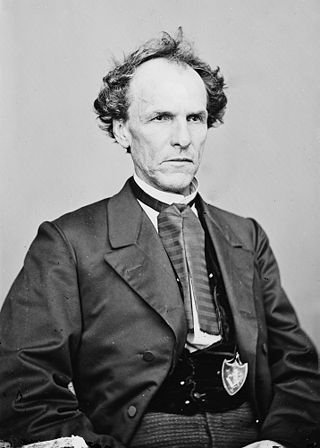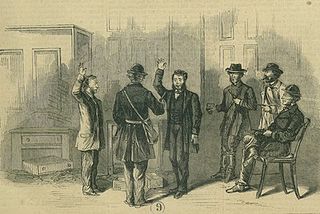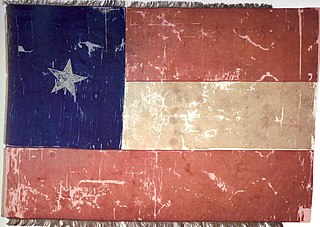Related Research Articles

The Battle of Gettysburg was a three-day battle in the American Civil War fought between Union and Confederate forces between July 1 and July 3, 1863, in and around Gettysburg, Pennsylvania. The battle, which was won by the Union, is widely considered the Civil War's turning point, ending the Confederacy's aspirations to establish an independent nation. It was the Civil War's bloodiest battle, claiming over 50,000 combined casualties over three days.

The Battle of the Wilderness was fought on May 5–7, 1864, during the American Civil War. It was the first battle of Lieutenant General Ulysses S. Grant's 1864 Virginia Overland Campaign against General Robert E. Lee and the Confederate Army of Northern Virginia. The fighting occurred in a wooded area near Locust Grove, Virginia, about 20 miles (32 km) west of Fredericksburg. Both armies suffered heavy casualties, nearly 29,000 in total, a harbinger of a war of attrition by Grant against Lee's army and, eventually, the Confederate capital, Richmond, Virginia. The battle was tactically inconclusive, as Grant disengaged and continued his offensive.

Quantrill's Raiders were the best-known of the pro-Confederate partisan guerrillas who fought in the American Civil War. Their leader was William Quantrill and they included Jesse James and his brother Frank.

Brigadier-General James Henry Lane was an American politician and military officer who was a leader of the Jayhawkers in the Bleeding Kansas period that immediately preceded the American Civil War. During the war itself, Lane served in the United States Senate and as a general officer in the Union Army. Although reelected as a Senator in 1865, Lane died by suicide the next year.

The history of the United States from 1849 to 1865 was dominated by the tensions that led to the American Civil War between North and South, and the bloody fighting in 1861-1865 that produced Northern victory in the war and ended slavery. At the same time industrialization and the transportation revolution changed the economics of the Northern United States and the Western United States. Heavy immigration from Western Europe shifted the center of population further to the North.

Little Round Top is the smaller of two rocky hills south of Gettysburg, Pennsylvania—the companion to the adjacent, taller hill named Big Round Top. It was the site of an unsuccessful assault by Confederate troops against the Union left flank on July 2, 1863, the second day of the Battle of Gettysburg, during the American Civil War.

Jayhawker and red leg are terms that came to prominence in Kansas Territory during the Bleeding Kansas period of the 1850s; they were adopted by militant bands affiliated with the free-state cause during the American Civil War. These gangs were guerrillas who often clashed with pro-slavery groups from Missouri, known at the time in Kansas Territory as "Border Ruffians" or "Bushwhackers". After the Civil War, the word "Jayhawker" became synonymous with the people of Kansas, or anybody born in Kansas. Today a modified version of the term, Jayhawk, is used as a nickname for a native-born Kansan.
The Battle of Jerusalem Plank Road, also known as the First Battle of the Weldon Railroad, took place during the American Civil War fought June 21–23, 1864, near Petersburg, Virginia. It was the first of a series of battles during the Siege of Petersburg aimed at extending the Union siege lines to the west and cutting the rail lines supplying Petersburg. Two infantry corps of the Union Army of the Potomac attempted to sever the railroad, but were attacked and driven off by the Confederate Army of Northern Virginia's Third Corps, principally the division of Brig. Gen. William Mahone. The inconclusive battle left the Weldon Railroad temporarily in Confederate hands, but the Union Army began to extend its fortifications to the west, starting to increase the pressure of the siege.

Devil's Den is a boulder-strewn hill on the south end of Houck's Ridge at Gettysburg Battlefield, used by artillery and sharpshooters on the second day of the 1863 Battle of Gettysburg during the American Civil War. A tourist attraction since the memorial association era, several boulders are worn from foot traffic and the site includes numerous cannons, memorials, and walkways, including a bridge spanning two boulders.

The St. Albans Raid was the northernmost land action of the American Civil War. Taking place in St. Albans, Vermont, on October 19, 1864, it was a raid conducted out of the Province of Canada by 21 Confederate soldiers who had recently failed in engagements with the Union Army and evaded subsequent capture in the United States. The mission of the raid was to rob banks to raise money, and to trick the Union Army into diverting troops to defend their northern border against further raids. The Confederates obtained the money, killed a local, and escaped back to Canada.

The Battle of Honey Springs, also known as the Affair at Elk Creek, on July 17, 1863, was an American Civil War engagement and an important victory for Union forces in their efforts to gain control of the Indian Territory. It was the largest confrontation between Union and Confederate forces in the area that would eventually become Oklahoma. The engagement was also unique in the fact that white soldiers were the minority in both fighting forces. Native Americans made up a significant portion of each of the opposing armies and the Union force contained African-American units.
Honey Island is an unincorporated community in Hardin County, Texas, United States. It is part of the Beaumont–Port Arthur Metropolitan Statistical Area. The Kountze Independent School District provides public schools for area students.

At the outbreak of the American Civil War in April 1861, Kansas was the newest U.S. state, admitted just months earlier in January. The state had formally rejected slavery by popular vote and vowed to fight on the side of the Union, though ideological divisions with neighboring Missouri, a slave state, had led to violent conflict in previous years and persisted for the duration of the war.
The following outline is provided as an overview of and topical guide to the American Civil War:

During the American Civil War, most of what is now the U.S. state of Oklahoma was designated as the Indian Territory. It served as an unorganized region that had been set aside specifically for Native American tribes and was occupied mostly by tribes which had been removed from their ancestral lands in the Southeastern United States following the Indian Removal Act of 1830. As part of the Trans-Mississippi Theater, the Indian Territory was the scene of numerous skirmishes and seven officially recognized battles involving both Native American units allied with the Confederate States of America and Native Americans loyal to the United States government, as well as other Union and Confederate troops.

The Cherokee in the American Civil War were active in the Trans-Mississippi and Western Theaters. In the east, Confederate Cherokees led by William Holland Thomas hindered Union forces trying to use the Appalachian mountain passes of western North Carolina and eastern Tennessee. Out west, Confederate Cherokee Stand Watie led primarily Native Confederate forces in the Indian Territory, in what is now the state of Oklahoma. The Cherokee partnered with the Confederacy in order to get funds, as well as ultimately full recognition as a sovereign, independent state.
Events from the year 1863 in the United States.
American Civil War alternate histories are alternate history fiction that focuses on the Civil War ending differently or not occurring. The American Civil War is a popular point of divergence in English-language alternate history fiction. The most common variants detail the victory and survival of the Confederate States. Less common variants include a Union victory under different circumstances from actual history, resulting in a different postwar situation; black American slaves freeing themselves by revolt without waiting for Lincoln's Emancipation Proclamation; a direct British and/or French intervention in the war; the survival of Lincoln during John Wilkes Booth's assassination attempt; a retelling of historical events with fantasy elements inserted; the Civil War never breaking out and a peaceful compromise being reached; and secret history tales. The point of divergence in such a story can be a "natural, realistic" event, such as one general making a different decision, or one sentry detecting an enemy invasion unlike in reality. It can also be an "unnatural" fantasy/science fiction plot device such as time travel, which usually takes the form of someone bringing modern weapons or hindsight knowledge into the past. Still another related variant is a scenario of a Civil War that breaks out at a different time from 1861 and under different circumstances.
The American Civil War bibliography comprises books that deal in large part with the American Civil War. There are over 60,000 books on the war, with more appearing each month. There is no complete bibliography to the war; the largest guide to books is more than 50 years old and lists over 6,000 titles.

The 5th Texas Infantry Regiment was a unit of Confederate States Army infantry volunteers created in 1861 that fought in the Army of Northern Virginia during the American Civil War. The unit was part of the famous Texas Brigade. The regiment fought at Eltham's Landing, Seven Pines, Gaines's Mill, Second Bull Run, South Mountain, Antietam, and Fredericksburg in 1862. It fought at Gettysburg and Chickamauga in 1863 and the Wilderness, Spotsylvania, Cold Harbor, and the Siege of Petersburg in 1864. The regiment surrendered to Federal forces on 9 April 1865 after the Battle of Appomattox Court House.
References
- 1 2 "Hardin County has its share of historical markers". bigthicketdirectory.com. Silsbee Bee.
- ↑ Loughmiller, Campell, and Lynn Loughmiller. Big Thicket Legacy. Austin: The University of Texas Press, 1977. Print.
- 1 2 3 4 5 6 7 8 9 10 11 12 13 14 15 16 17 18 19 Loughmiller, Campbell; Loughmiller, Lynn (1977). Big Thicket Legacy. Denton: University of North Texas Press. pp. 69–72. ISBN 9781574411560.
- ↑ "Rich Man's War, Poor Man's Fight – The Draft and the Civil War Administration". Civil War Omnibus. 30 September 2008. Retrieved 14 March 2012.
- ↑ Moore, Albert (1924). Conscription and Conflict in the Confederacy. New York: Macmillan Company. pp. 1–26. ISBN 9781570031526.
- 1 2 3 4 5 6 7 Archie, McDonald (16 December 2010). "Kaiser's Burnout and Other Big Thicket Adventures". Texas Escapes. Retrieved 14 March 2012.
- ↑ Block, William. "Wild Ones of the Big Thicket". wtblock.com. Retrieved 14 March 2012.
- ↑ Wooster, Robert. "HONEY ISLAND, TX". The Handbook of Texas Online. Texas State Historical Association. Retrieved 30 March 2009.
- ↑ E. R. Bills (author). Texas Far & Wide: The Tornado with Eyes, Gettysburg's Last Casualty, The Celestial Skipping Stone and Other Tales. Charleston, SC: The History Press, 2017.
- 1 2 "Texas Civil War Timeline". texasbob.com. Retrieved 30 March 2009.
- ↑ E. R. Bills (author). Texas Far and Wide: The Tornado with Eyes, Gettysburg's Last Casualty, the Celestial Skipping Stone and Other Tales. Charleston, SC: The History Press, 2017.